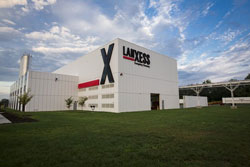Lanxess starts up US$15 mn capacity expansion for high-performance plastics in the US

Specialty chemicals company Lanxess has started up a second production line for high-performance plastics compounding at its facility in Gastonia, North Carolina, as planned.
The new line represents an investment of about US$15 million and doubles the site’s production capacity from 20,000 to 40,000 metric tonnes annually.
In the plant, the basic polymers polyamide (PA) and polybutylene terephthalate (PBT) are mixed and refined with special additives and glass fibre, according to client requirements, to make the high-performance plastic product lines Durethan and Pocan. They are used primarily in the automotive industry to manufacture lighter-weight plastic components that can replace metal parts in vehicles, contributing to greater fuel efficiency and reduced emissions.
Hubert Fink, Member of the Board of Management of Lanxess says that this new investment shows the company’s strengthened focus on high-performance compounds and underlines our strategy to shift this business towards higher-value-added markets; further adding that the capacity expansion in Gastonia also shows the same commitment to North America.
In the coming years, Lanxess plans to further invest EUR50 to 100 million for organic growth in its high-performance plastics business. “With the investments, we will be further balancing the capacities in our polyamide value chain and driving the globalization of our engineering plastics business,” said Michael Zobel, head of Lanxess' business unit High Performance Materials.
Meanwhile, Lanxess expects global demand for engineering plastics in automotive applications to grow by 7% annually (CAGR 2015-2020). This is being driven by rising car production and the trend towards more fuel-efficient automobiles. For example, in the US, automakers must meet government-mandated Corporate Average Fuel Economy (CAFE) regulations, which indicate the average distance that has to be covered per one gallon of fuel. By 2025, an average fleet-wide fuel efficiency of 54.5 miles per gallon will be required compared to 34.1 miles per gallon in 2016.
In light of the growing demand for engineering plastics for the automotive sector in the US, Antonis Papadourakis, Lanxess Corporation President and CEO says that this growth can be supported by th firm’s expanded capacity. “We will remain a reliable supplier to our North American customers, ” he added.
Lanxess is a global manufacturer in plastic-metal hybrid and composites technologies that enable engineers to cost-efficiently reduce part weight in automobiles. Depending on the component, a part designed with high-performance plastics can weigh 10 to 50% less than a metal version. Lanxess plastics are used, for example, in engine applications, door structures, front ends, pedals, and interior components. Another field of application is the electrical and electronics industry
The business unit High Performance Materials is highly backward integrated in the value chain. It produces the precursors for its high-performance plastics, like glass fibres for the PA and PBT compounds and the polyamide 6 monomer caprolactam, all in its own plants.
The business unit, with roughly 1,500 employees worldwide, operates other production facilities worldwide aside from the US: Belgium (Antwerp), Germany (Krefeld-Uerdingen, Hamm-Uentrop, Brilon), China (Wuxi), India (Jhagadia), and Brazil (Porto Feliz). It is part of the Performance Polymers segment, which generated around EUR4.1 billion in total sales in fiscal year 2014.
(PRA)Copyright (c) 2016 www.plasticsandrubberasia.com. All rights reserved.






































